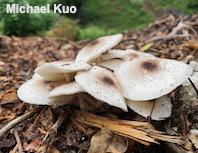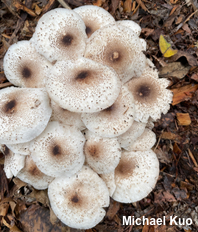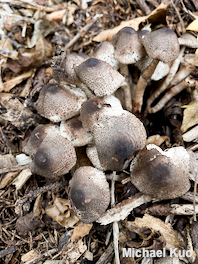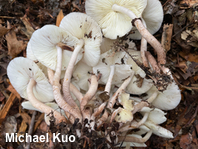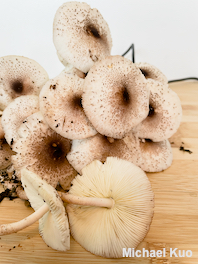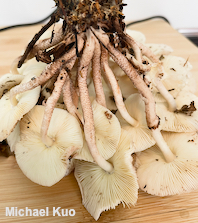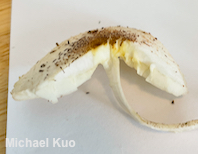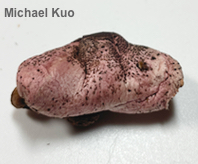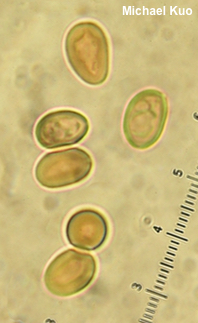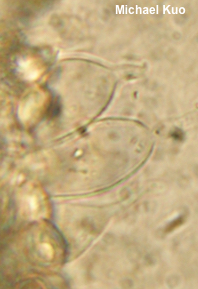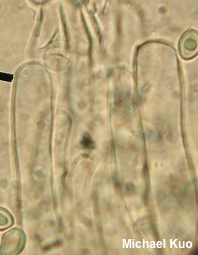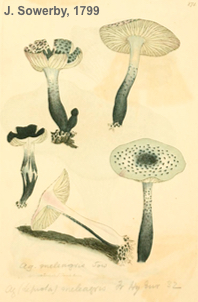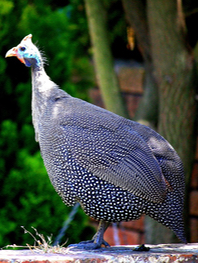| Major Groups > Gilled Mushrooms > Pale-Spored > Lepiotoid Mushrooms > Leucoagaricus meleagris |

|
[ Basidiomycota > Agaricales > Agaricaceae > Leucoagaricus . . . ] Leucoagaricus meleagris by Michael Kuo, 3 June 2024 Leucoagaricus meleagris, also known as "Lady Arden's hot-bed guinea hen" (hang on; I'll get to that), is an uncommon lepiotoid mushroom that appears in woodchips and compost beds, growing in tightly-packed clusters. The caps have dark brown centers and, elsewhere, fine brown scales over a whitish ground color; the gills are free from the stem and become pale yellow with development; the stems are finely fibrillose-scaly and occasionally feature a brown-edged, collapsed ring. The flesh turns lemon yellow, then slowly reddish, when sliced, at least in the stem apex. Leucoagaricus americanus is very similar, and is often found in woodchip beds—but it is a larger, stockier species, and it does not tend to grow in clusters (additionally, under the microscope, its spores have a more discernible pore and the terminal cells of its pileipellis tend to be more pointed, rather than bluntly rounded). Sowerby's original description of Agaricus meleagris (1799) is very brief, and begins with: "I am obliged to Lady Arden for beautiful specimens of this Agaric found in an hot-bed, May 24th, 1798. I have named it A. meleagris." Since the epithet meleagris is Greek for "guinea hen" (μελεαγρις), the best common name for this fungus is clearly, as I said above, "Lady Arden's hot-bed guinea hen." Why Sowerby thought the mushroom looked like a guinea hen is unclear, but he used an illustration of the species, which appears to the right, as a substitute for a thorough textual description—kind of like when I get lazy and write "see photos" instead of writing out the details of a mushroom collection. Lepiota meleagris and Leucocoprinus meleagris are synonyms. According to Vellinga (2000) Lepiota sanguiflua, described from Florida by Murrill (1945) is likely the same species. Description: Ecology: Saprobic, growing in clusters and gregariously in woodchips or compost; summer and fall; originally described from England (Sowerby 1799); widely distributed but uncommon in Europe and North America; also reported from Asia, Oceania, and South America. The illustrated and described collections are from Ohio. Cap: 2.5–9 cm across; broadly convex to broadly bell-shaped or nearly flat; dry; brown and bald over the center; mid-zone with fine brown scales over a whitish ground; marginal area with only a few scales, becoming finely lined for about 5 mm; sometimes bruising yellowish, then reddish after up to 24 hours. Gills: Free from the stem; close or crowded; short-gills frequent; whitish at first, becoming pale lemon yellow; bruising slowly brownish. Stem: 6.5–15 cm long; 4–8 mm thick at the midpoint; narrowly spindle-shaped, with a tapered base that sometimes roots into the substrate; without a ring, or with an ephemeral, collapsing, brown-edged ring; white and bald above; below with fine brown fibrils and scales; basal mycelium white. Flesh: White; changing to yellow, then slowly red when sliced, at least in the stem apex. Odor: Not distinctive. Chemical Reactions: KOH dark pink on cap surface. Dried Specimens: Herbarium specimens feature rose pink caps for about a year before becoming brown. Spore Print: White. Microscopic Features: Spores 7–12 x 5–7 µm; broadly ellipsoid; with a very tiny pore that is not always visible; smooth; walls 1 µm thick; hyaline in KOH; inamyloid; at least some spores moderately dextrinoid. Basidia 25–28 x 9–12 µm; abruptly clavate; 4-sterigmate or occasionally 2-sterigmate. Pleurocystidia not found. Cheilocystidia 30–70 x 10–18 µm; clavate to fusiform or lageniform; often irregularly mucronate; smooth; thin-walled; hyaline in KOH. Pileipellis a cutis with aggregations of upright elements; elements 4–12 µm wide, smooth, hyaline to brownish in KOH; apex of most terminal cells bluntly rounded rather than acute. Clamp connections not found. REFERENCES: (J. Sowerby, 1799) R. Singer, 1951. (Kauffman, 1924; Smith & Weber, 1987; Vellinga, 2000; Vellinga, 2001; Hemmes & Desjardin, 2002; Vellinga, 2004; Vellinga, 2004b; Bougher, 2009; Buczacki et al., 2013; Lange, 2018; Kibby, 2020.) Herb. Kuo 09032201, 10082301. This site contains no information about the edibility or toxicity of mushrooms. |
© MushroomExpert.Com |
|
Cite this page as: Kuo, M. (2024, June). Leucoagaricus meleagris. Retrieved from the MushroomExpert.Com Web site: http://www.mushroomexpert.com/leucoagaricus_meleagris.html |
